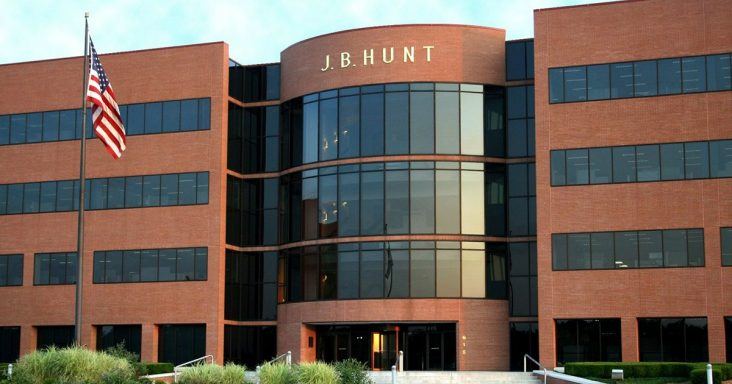J.B. Hunt earnings, revenue rise in second quarter
by July 19, 2022 5:59 pm 1,270 views

Lowell-based carrier J.B. Hunt Transport Services Inc. exceeded analyst expectations in the second quarter as earnings jumped by 48.3% and revenue rose by 31.9%. All segments contributed to the revenue rise amid strong freight demand.
After the markets closed Tuesday (July 19), J.B. Hunt posted second-quarter earnings of $255.34 million, or $2.42 per share, up from $172.16 million, or $1.61 per share, in the same period in 2021. Revenue rose to $3.83 billion, from $2.9 billion. J.B. Hunt beat earnings estimates of $2.31 per share, based on a consensus of 22 analysts. The company also beat revenue estimates of $3.6 billion.
In a report on the earnings, analysts Justin Long and Jack Atkins and associate Brady Lierz, all of Little Rock-based Stephens Inc., said the upside was the revenue, but operating margins were below expectations. The analysts also noted J.B. Hunt incurred a net pre-tax headwind of $18.4 million from higher casualty claims and workers’ compensation benefits. This had a negative impact of 13 cents on earnings per share numbers.
In a second-quarter earnings call, J.B. Hunt executives highlighted the continued strength in freight demand, a more stable driver market, challenges with acquiring equipment and rail velocity issues that are expected to improve in the second half of the year.
“We remain in a leadership position across our many businesses and from a position of strength financially and on the team’s experience and ability to navigate through an ever-changing, constantly-evolving global supply chain,” CEO John Roberts said. “I am encouraged to be in healthy, cash-generating businesses across the company.”
Total freight transactions in the Marketplace for technology platform J.B. Hunt 360 rose by 11% to $556 million, from $500 million in the same period in 2021.
In the first half of 2022, net income rose by 54.6% to $498.66 million, or $4.72 per share, from $318.76 million, or $2.98 per share, in the same period in 2021. Revenue rose by 32.6% to $7.32 billion, from $5.52 billion.
Shares of J.B. Hunt (NASDAQ: JBHT) closed Tuesday at $174.46, up $6.36 or 3.78%. In the past 52 weeks, the stock has ranged between $153.92 and $218.18.
Following are second-quarter results by segment compared to the same period in 2021:
• Intermodal
Operating income increased by 50% to $202.52 million, from $134.64 million. The income comprised 57% of the carrier’s total income. Revenue rose by 42% to $1.83 billion, from $1.28 billion. The revenue comprised 48% of the carrier’s total revenue.
• Dedicated
Operating income increased by 13% to $89.19 million, from $79.01 million. The income comprised 25% of the carrier’s total income. Revenue rose by 39% to $863.03 million, from $621.17 million. The revenue comprised 22% of the carrier’s total revenue.
• Brokerage
Operating income increased by 658% to $23.62 million, from $3.11 million. The income comprised 7% of the carrier’s total income. Revenue rose by 3% to $623.23 million, from $607.61 million. The revenue comprised 16% of the carrier’s total revenue.
• Truckload
Operating income increased by 76% to $24.96 million, from $14.19 million. The income comprised 7% of the carrier’s total income. Revenue rose by 46% to $268.79 million, from $183.63 million. The revenue comprised 7% of the carrier’s total revenue.
• Final Mile Services
Operating income increased by 20% to $12.84 million, from $10.69 million. The income comprised 4% of the carrier’s total income. Revenue rose by 21% to $257.36 million, from $212.26 million. The revenue comprised 7% of the carrier’s total revenue.
BROADER TRENDS
American Trucking Associations’ (ATA) advanced seasonally adjusted For-Hire Truck Tonnage Index rose by 2.7% in June, from May. The index was up 7.9% in June, from the same month in 2021. It’s the 10th consecutive year-over-year increase and the largest since June 2018.
“June’s jump tells me a couple of things,” ATA Chief Economist Bob Costello said. “First, the transition in the freight market from spot back to contract continues. ATA’s tonnage index is dominated by contract freight, so while the spot market has slowed as freight softens, contract carriers are backfilling those losses with loads from shippers reducing spot market exposure. Essentially, the market is transitioning back to pre-pandemic shares of contract versus spot market. Second, and perhaps equally important, while economic growth is expected to be soft overall in the second quarter, the goods-economy wasn’t as bad as feared.”
